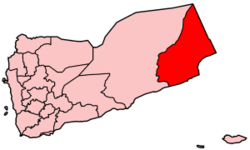- Mahra Sultanate
-
Mahra Sultanate of Qishn and Socotra
سلطنة المهرة في قشن و سقطرة18th century–1967  →
→Flag
Map of the Protectorate of South Arabia in 1965. Capital Qishn (Mahra);
Tamrida/Hadibu (Socotra)Language(s) Arabic Mahri Religion  Islam
IslamGovernment Monarchy History - Established 18th century - Disestablished 1967 The Mahra Sultanate of Qishn and Socotra (Arabic: سلطنة المهرة في قشن و سقطرة Salṭanat Mahrah fī Qishn wa Suquṭrah) or sometimes the Mahra Sultanate of Ghayda and Socotra (Arabic: سلطنة المهرة في الغيضاء و سقطرة Salṭanat Mahrah fī-l Ghayḍā’ wa Suquṭrah) was a sultanate that included both the historical region of Mahra and the Indian Ocean island of Socotra in what is now eastern Yemen. It was ruled by the Banu Afrar (Arabic: بنو عفرار Banū ʿAfrār, also known as بن عفرير) dynasty and is sometimes called Mahra State in English.
History
 Map of contemporary Yemen showing Al Mahrah Governorate.
Map of contemporary Yemen showing Al Mahrah Governorate.
The capitals of the Mahra Sultanate were Qishn in Mahra and Tamrida (Hadibu) on Socotra. During 1886, the sultanate became a British protectorate and later became a part of the Aden Protectorate. In the 1960s, Mahra declined to join the Federation of South Arabia but remained under British protection as part of the Protectorate of South Arabia. In 1967, the sultanate was abolished and Mahra became part of newly independent South Yemen which united with North Yemen in 1990 to become the Republic of Yemen. Today the Mahra area (without Socotra) is the Al Mahrah Governorate of Yemen.
In addition to Arabic, Mehri, a Modern South Arabian language is spoken in Mahra. Mahra shares with the neighbouring Dhofar in Oman cultural traits such as the modern South Arabian language spoken and the importance of frankincense, These regions also share geographic and climatic ties, which distinguish them from the surrounding desert terrain, mostly due to the beneficial action of the khareef monsoon.
External links

This Middle Eastern history-related article is a stub. You can help Wikipedia by expanding it.


